#Empowering oneself through self-reflection
Explore tagged Tumblr posts
Text
Embark on a Transformative Journey of Self-Discovery with the "Empowered Journey" Guided Reflection Journal
Empowered Journey Journal: Your Companion on the Path to Mindfulness and Growth Dear Reader, I'm thrilled to share the Empowered Journey Guided Reflection Journal is now available on Amazon! This interactive companion to the Empowered Journey book. Hafsa
Introducing A Guided Reflection Journal for “Empowered Journey” In an increasingly fast-paced world, introspection and self-reflection have never been more integral to personal growth and well-being. Recognizing this, the “Empowered Journey: A Holistic Guide to Mindfulness, Resilience, and Personal Growth” companion journal has been thoughtfully crafted to deepen readers’ self-discovery…
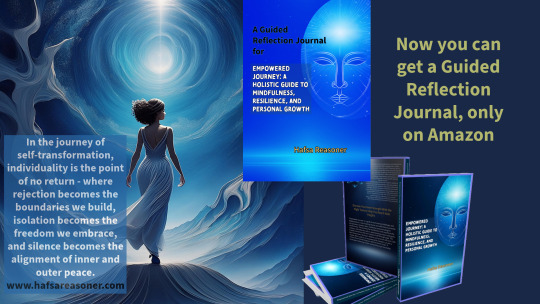
View On WordPress
#Core values#Empowered Journey#Empowering oneself through self-reflection#Fulfillment#Growth mindset#Guided journals for introspection#Guided Reflection Journal#Holistic approach to self-improvement#Holistic guide#Inner strength#Intentional living#Introspection#Journaling as a path to self-awareness#Journaling for self-improvement#Mindfulness#Mindfulness and resilience exercises#Personal development#Personal growth#Practical strategies for building resilience#Resilience#Self-Awareness#Self-discovery#Self-reflection#Stress management#Tools for self-discovery and personal growth#Transformation
0 notes
Text
Rahu and Ketu both deal with illusions of perception and their influence on our emotions, psyche and quality of life experience. That concept is called “Tamas”, the smoky mirror, looking in the reflection with a biased eye, and then either breaking or controlling that bias. The Nodes simply approach this concept in a completely different way.
Rahu’s ultimate goal is creating an illusion that is enjoyable, which is of course highly relative to our personal desires. Rahu is about seeing in the mirror what you want to see, about wanting to experience a reflection that is in alignment with a vision you have for this human life. There is inherently nothing wrong with the concept, because we are given this human life for enjoyment among many reasons, and it is natural to want to create a version of this incarnation according to our preference. The very desire to have a certain experience, comes after all, from our very soul, which is what people often skip on, that Rahu in its positive illusory creation has a deeper spiritual meaning.
The issue only begins, when a person over-identifies with their desired illusion, which should be more aspirational than anything else, and forgets themselves and the reality of their actions, when there is nothing solid to back it up. Since Rahu wants to create an illusion that is agreeable, anything that is not built on a solid foundation will ruin that, and take away Rahu’s creations with it, until the person steps into self-accountability. Embracing your Rahu is like directing a film, you want a certain message and visual impact in your creation, but the real person needs something solid behind the scenes to achieve their vision. Say you have Rahu in the 7th and you really desire the picture of a good partner that completes you, that good relationship. If you don’t really get to know the other person, if you’re not a good partner yourself, it will shatter your illusion, because a good “film” needs solid tools of creation.
Of course, we also can’t discount that there is an element of fear in Rahu, and often that pleasant image we try to construct is something we adopt like a mask, something our early environment taught us is necessary for survival, to get accepted, to get our desires met. So ultimately the Tamas created here is about fulfillment of our very real desires, and finding practical ways to achieve them without the cookie cutter filter, or at least making even a lie solid enough to hold long enough for it to become real.
While Rahu embraces more so the positive concept of material illusion in the aspirational, creative sense, Ketu focused on the negative aspect of Tamas, which is an illusion of ignorance that holds us back. As such, Ketu’s primary task is breaking through that illusion and freeing the native. The sign of Ketu and the dispositor will show what kind of illusion the person is facing, which comes from the psychological manipulation of the environment that disempowered you strongly in that area. Then, Ketu will free you from that illusion and empower you, by showing you that the opposite is possible, and stripping negative self concepts from you which are not real and were never fair to the authentic expression of the essence of your soul. That can be scary, because as humans we get attached to our ideas about ourselves, even the negative ones, but if we accept this process, the feeling of freedom is incomparable, and our levels of self confidence and happiness will increase with that freedom, if only one is ready to give up attachment to the perceived negative side of oneself.
To follow with the Rahu example, let’s say you have Ketu in the 1st house. Based on the sign and the dispositor, you have a certain self concept, that will inherently contain an illusion of negativity, but something you may be fundamentally attached to “I can’t do xyz because I’m just me”. Ketu will work on removing that illusion from you, and show you what you are really capable of as a person and help you construct a spiritually realistic sense of identity.
#astrology#vedic astrology#jyotish#astro observations#astro notes#vedic astro observations#vedic astro notes
164 notes
·
View notes
Text
WHAT'S IN STORE FOR YOU THIS SPRING?

This is meant to be a fun, general reading, so it may not resonate with everyone. Take what resonates for you and leave the rest behind! Please take a moment to breathe, focus on your intuition, and choose the photo that calls to you. Each holds a unique message for you!




𐙚 • 𝑃𝑖𝑙𝑒 1
This spring, there may be a sense of unpredictability or feeling like things are not quite going as planned. It could feel like external circumstances are delaying progress, leading to moments of frustration or uncertainty. However, patience and persistence will be key during this time. While results may not be immediate, the efforts that have been put in will eventually pay off, making it important to stay committed and trust the process.
Despite any setbacks, there is a strong energy of personal fulfillment and stability emerging. Hard work and dedication will bring a deep sense of satisfaction, and there may be opportunities for financial or material growth. A steady and reliable approach will lead to long-term rewards, emphasizing the importance of staying practical and grounded. Looking ahead and planning for the future will also be crucial, as opportunities are beginning to unfold, bringing a sense of optimism and progress.
However, there may be moments when rest and reflection are needed. Taking breaks and allowing time to recharge will help maintain balance and clarity. With a new beginning on the horizon, this is a period where financial and career-related growth is possible, particularly through careful planning and a responsible approach. Stability and security are within reach, especially for those who remain focused on their goals and take measured steps toward their ambitions.

𐙚 • 𝑃𝑖𝑙𝑒 2
This spring will be a time of awakening and self-realization. There is a strong call to reflect on past choices and embrace personal growth, allowing for a fresh perspective on life. A period of breaking free from unhealthy patterns or influences is emerging, creating space for newfound independence and clarity. While it may take effort to fully release what no longer serves, the process will be empowering and bring a sense of liberation.
However, there may be moments of imbalance or uncertainty, particularly when it comes to managing responsibilities or expectations. Traditional structures or beliefs may feel restrictive, leading to a desire to forge a unique path rather than conforming to societal norms. Moving forward may not always be easy, as lingering doubts or unresolved emotions could create hesitation. Yet, the ability to manifest new opportunities is strong, and taking control of one's own direction will be key to overcoming any obstacles.
Even in the face of challenges, there is a strong energy of personal fulfillment and success. The power to shape the future lies in the ability to harness inner strengths and talents. While there may be moments of disappointment or reflection on what has been lost, there is also the opportunity to focus on what remains and build something even stronger. By embracing self-confidence and looking ahead with optimism, this season holds the potential for transformation and deep personal fulfillment.

𐙚 • 𝑃𝑖𝑙𝑒 3
This spring may bring shifts in relationships, whether romantic, platonic, or professional. There could be moments of disconnect or misalignment, making it important to reassess connections and ensure they align with personal values and needs. However, stability and self-sufficiency will take center stage, offering a strong foundation for personal growth. This is a time to focus on financial independence, nurturing oneself, and creating a comfortable and abundant life through patience and effort.
While progress is steady, there may be moments of doubt or feeling uncertain about the future. It could feel like hopes or dreams are slightly out of reach, requiring faith and perseverance to keep moving forward. Hard work will pay off, but results may take time, emphasizing the importance of patience and long-term planning. Rest and self-care will be essential, as pushing too hard without pause could lead to burnout or unnecessary stress.
Holding onto stability will be a theme, whether that means managing finances carefully, protecting personal energy, or maintaining emotional boundaries. Intuition will play a key role this season, guiding important decisions and revealing truths that may not be immediately visible. While there may be moments of feeling unprepared or hesitant to stand up against external pressures, trusting inner wisdom and maintaining balance will help navigate any challenges. This season offers a mix of growth, reflection, and inner strength, leading to deeper self-awareness and resilience.

Blessed Ostara!!
If you're looking for a personalized reading tailored specifically to your energy, feel free to message me to book a session or visit my Ko-fi page to schedule one here: KO-FI
#tarot#selling tarot reading#tarot cards#tarot reading#witchcraft#pick a card#pick a deck#pick a photo#pick a picture#spring#spring reading#ostara#spring equinox
91 notes
·
View notes
Text

I put on one of my favorite records to help me focus, but I got distracted by reflections on my long-held belief that Rooster is one of the best expressions of empathy and healing your inner child that I've ever heard put to music. Let me explain. (Trigger warnings—some sensitive topics below cut (childhood neglect/abuse mentioned in a non-explicit way, non-explicit mention of combat related trauma, process of healing also discussed).
Jerry Cantrell wrote this song while placing himself in the shoes of his father, a Vietnam combat veteran. The trauma of Cantrell Sr.’s wartime experience contributed to him being a distant, cold partner and father, and this led to Jerry’s mother, Gloria, divorcing Cantrell Sr. and taking Jerry and his siblings away from the home for their safety and well-being. Jerry didn't spend much time with his father following the divorce, and resentment towards him grew.
Now, children are good at coming up with explanations for neglect and abuse. These explanations are usually miles away from the truth (for example - my Dad doesn't spend time with me because I'm a bad kid and I’m not worthy of his time). These explanations can then impact these children’s self-esteem, self-efficacy, and ability to form healthy attachments for the rest of their lives unless they take the time to acknowledge, deconstruct, and restructure them. I’ve heard horrendous things that have happened to children, told to me by people in their 80s who are still working to heal from these psychological wounds. And forgiveness is not the answer for everyone, despite what pop psychologists may spout.
It isn't necessary to forgive your abuser for you to find healing. It helps some individuals but isn't a requisite. There is no one-size-fits-all approach to recovery. The literature indicates understanding and self-awareness as more relevant and beneficial for a broader range of situations, which Jerry was working towards in “Rooster.” He was thinking, why was my father this way? He acknowledged Cantrell Sr.’s behavior towards him wasn't little Jerry’s fault. That there was nothing he could have done to change things and nothing he did made him deserving of what he experienced. He was 7 years old when they left his father. A baby. But these babies blame themselves. I've seen it countless times. So Jerry being able to sit down and work through what he experienced and the reasons why he experienced it and creating something so amazing in the process is truly incredible.
Important to note, gaining this understanding is not providing excuses for inexcusable behavior. It is instead about empowering oneself to finally let go of the misplaced guilt and shame that often accompany these types of experiences. To realize that you are not, at your core, rotten and deserving of bad things. Rather, you are a whole, multifaceted human being, capable of “good” decisions and actions (which don't make you an overall “good”) person, and “bad” decisions and actions (which don't make you an overall “bad” person) deserving of love, care, and respect from yourself and others.
So Jerry writes this song, gaining an understanding of his father’s traumas and how they contributed to his own childhood experience. He finds healing and reconnection through the process (again, reconnection and reconciliation are not always the goal). Then Layne sings the song. And he gains an understanding of Cantrell Sr.’s experience. The song becomes a hit, and millions of people around the world hear it. Many more find a sense of understanding and healing through it. Empathy is iterative. It spreads and heals, maybe not always to this extent. But if even one person can be positively impacted by being treated/ treating another with empathy and compassion, I think it's well worth it.
#alice in chains#dirt album#physical media#vinylcollector#vinyl records#empathy#layne staley#inner child work#jerry cantrell#tw childhood trauma#tw child abuse#tw child neglect#reflection#digital diary#rooster#i had a stressful day at work#so I'm posting a#long post#as a treat to myself#music
15 notes
·
View notes
Note
Hello Umm , about the asteroid lilith(1181) how does it differ from H12, H58 and H13 in terms of energy and persona. Also what if lilith(1181) is conjunct pluto tightly 0° (5th house in Sagittarius) .
Asteroids and points named Lilith (1181, H12, H58, and H13) each represent different aspects and interpretations of the Lilith archetype in astrology:
1. Asteroid Lilith (1181):
- Represents the independent and assertive feminine energy.
- Associated with themes of autonomy, rebellion, and empowerment.
- Highlights where one seeks freedom and rejects societal norms.
2. Dark Moon Lilith (H12):
- Represents the shadow side of the feminine, often linked to suppressed rage, sexuality, and primal instincts.
- Emphasizes themes of rejection, hidden desires, and unacknowledged emotions.
3. Black Moon Lilith (H58):
- Calculated as the lunar apogee, representing the furthest point of the Moon's orbit from the Earth.
- Symbolizes the untamed, raw, and instinctual aspects of femininity.
- Associated with themes of deep emotional and sexual power, as well as areas where one might experience extremes or feel outcast.
4. Osculating Lilith (H13):
- Represents the actual position of the lunar apogee at any given time.
- Reflects the dynamic and ever-changing nature of Lilith's influence.
- Highlights the fluctuating and unpredictable aspects of one's primal energy and emotional intensity.
Lilith (1181) Conjunct Pluto (0°) in 5th House, Sagittarius
When Asteroid Lilith (1181) is tightly conjunct Pluto in the 5th house in Sagittarius, it combines the themes of autonomy and empowerment with the transformative and intense energy of Pluto. Here's what this might signify:
1. Intense Creativity and Passion:
- The 5th house is associated with creativity, self-expression, and romance. Lilith conjunct Pluto here suggests a powerful drive to create and express oneself authentically, often through unconventional or transformative means.
2. Transformative Romantic Relationships:
- Romantic relationships may be intense, transformative, and potentially challenging. There can be a strong attraction to partners who embody Plutonian qualities (powerful, intense, transformative).
3. Empowered Self-Expression:
- This aspect empowers one to express their individuality and creativity in bold and fearless ways. There might be a strong desire to break free from societal norms and expectations.
4. Deep Psychological Exploration:
- With this conjunction in Sagittarius, there is a profound desire for knowledge and truth. This placement can lead to exploring deep psychological or philosophical truths, often through creative or expressive outlets.
5. Rejection of Conventionality:
- A strong inclination to reject conventional paths in favor of more profound, transformative experiences. This could manifest in a career in the arts, teaching, or other Sagittarian pursuits, approached with an intense and transformative perspective.
©️kleopatra45
#astrology#astrology community#astro notes#astroblr#astrology readings#astrology tumblr#astrology observations#houses in astrology#astro community#lilith#astrology asteroids#asteroid astrology#asteroids#asteroids in astrology
44 notes
·
View notes
Text
Your Human Design Profiles
Human design charts have gained popularity as a unique approach to understanding oneself. Rooted in astrology, the I Ching, Kabbalah, and other systems, these charts offer insights into personality traits, strengths, and potential life paths. While some find them enlightening and resonant, others may view them skeptically due to their complex and multifaceted nature. Ultimately, opinions on human design charts vary, and individuals should explore them with an open mind and consider them as one of many tools for self-discovery.
Find out your profile here:
🚀 1/3: Investigator/Martyr With the essence of exploration, the Investigator/Martyr profile seeks to understand life through a lens of experimentation and courage. Balanced between introspection and action, this profile dances with the mysteries of existence, uncovering truths that propel growth.
🌟 1/4: Investigator/Opportunist A harmonious blend of curiosity and adaptability, the Investigator/Opportunist profile embraces the dance of life's opportunities. Curving between reflection and spontaneity, it navigates the world with an open heart, collecting experiences that shape its unique path.
🎭 2/4: Hermit/Opportunist A cosmic fusion of introspection and spontaneity, the Hermit/Opportunist profile thrives in the delicate balance between solitude and connection. Embracing the depths of inner wisdom while engaging with the external world, it weaves a tapestry of profound insights.
🌌 2/5: Hermit/Heretic Guided by the realms of knowledge and transformation, the Hermit/Heretic profile embarks on a journey of understanding and change. It moves between solitude and rebellion, unveiling wisdom that challenges the norms and beckons growth.
🌀 3/5: Martyr/Heretic A dance between transformation and rebellion, the Martyr/Heretic profile ventures into uncharted territories of change and authenticity. Balanced between sacrifice and assertion, it ignites a revolution within, challenging the status quo.
🌄 3/6: Martyr/Role Model The Martyr/Role Model profile navigates the terrain of sacrifice and guidance, embodying the essence of a transformative leader. It finds purpose in inspiring others while embracing the challenges that pave the way for collective growth.
🔥 4/6: Opportunist/Role Model With the fire of spontaneity and leadership, the Opportunist/Role Model profile blazes a trail of inspiration and action. Balancing between flexibility and guidance, it weaves connections that empower both self and others.
🌟 4/1: Opportunist/Investigator The Opportunist/Investigator profile dances between adaptability and exploration, driven by the desire to learn and experience. It embodies the art of seizing opportunities while delving into the depths of understanding.
🌀 5/1: Heretic/Investigator Rooted in transformation and exploration, the Heretic/Investigator profile journeys through the realms of rebellion and understanding. It challenges conventions and seeks knowledge, igniting change with a quest for truth.
🌌 5/2: Heretic/Hermit Guided by the fusion of transformation and introspection, the Heretic/Hermit profile explores the depths of wisdom and authenticity. It unearths truths that challenge norms and embraces solitude as a source of growth.
🌄 6/2: Role Model/Hermit The Role Model/Hermit profile radiates a blend of guidance and introspection, embracing the role of a transformative teacher. Balancing between leadership and solitude, it imparts wisdom while delving into the mysteries of the self.
🔥 6/3: Role Model/Martyr With the fire of leadership and courage, the Role Model/Martyr profile paves the way for transformation and growth. It combines guidance and sacrifice, embodying the essence of a visionary leader.
Disclaimer: Human design profiles offer insights but are not predictive. They are tools for self-awareness and personal growth.
#human design chart#human design profile#human design#1/3#1/4#2/4#2/5#3/5#3/6#4/6#4/1#5/1#5/2#6/2#6/3
173 notes
·
View notes
Text
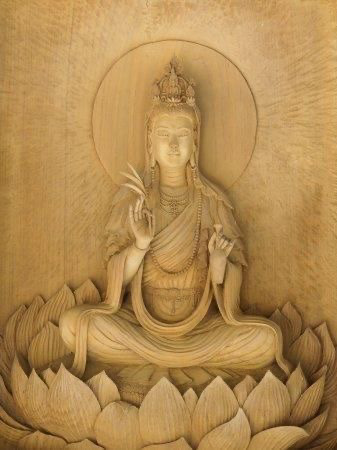
The Power of Exchange:
Alleviating Suffering Through Compassionate Practice
In the journey towards alleviating the suffering of others, Tibetan Buddhist teachings emphasize the transformative practice of exchanging oneself with others. This profound concept, rooted in compassion and empathy, suggests that to effectively alleviate the suffering of others, one must first cultivate the ability to empathize deeply with them. This process begins with the individual, as they undertake the courageous task of acknowledging and addressing their own suffering.
The sequence of exchange, as articulated by Tibetan Buddhist master Je Tsongkhapa, starts with a fundamental shift in perspective—one that encourages individuals to confront their own suffering head-on. By doing so, practitioners develop the capacity to recognize the universal nature of suffering and empathize with the struggles of others. This initial step is crucial, as it lays the foundation for genuine compassion and altruism to emerge.
To commence the sequence of exchange, practitioners are encouraged to reflect upon their own experiences of suffering—both past and anticipated future sufferings. This introspective practice involves acknowledging and accepting one's vulnerabilities, fears, and pains without avoidance or denial. By courageously confronting their own suffering, individuals cultivate empathy and compassion towards themselves, paving the way for a deeper connection with the suffering of others.
Once individuals have sincerely embraced their own suffering, the next step in the sequence of exchange involves mentally assuming the suffering of others. This profound act of empathy requires practitioners to visualize themselves taking on the pain, struggles, and challenges faced by others. Through this empathetic engagement, individuals transcend the barriers of self-concern and develop a profound sense of interconnectedness with all sentient beings.
The practice of exchanging oneself with others is not merely a theoretical exercise but a transformative process that cultivates genuine compassion and altruism. By undergoing this sequence of exchange, individuals not only alleviate their own suffering but also become empowered agents of positive change in the world. This compassionate practice fosters a deep sense of empathy, kindness, and interconnectedness—essential qualities for building a more compassionate and harmonious society.
Moreover, the sequence of exchange serves as a powerful antidote to self-centeredness and egocentric attitudes. By shifting the focus from self-concern to concern for others, individuals break free from the confines of selfishness and cultivate a genuine sense of altruism and generosity. This transformative shift in perspective fosters a deep sense of inner peace and fulfillment, as individuals align their actions with the universal values of compassion and kindness.
In essence, the sequence of exchange is a profound spiritual practice that invites individuals to transcend their own suffering and embrace the suffering of others with empathy and compassion. By cultivating a genuine sense of interconnectedness and altruism, practitioners become catalysts for positive change in the world, embodying the timeless wisdom of compassion and love. As we embark on this journey of exchange, may we all strive to alleviate the suffering of others and cultivate a more compassionate and harmonious world for generations to come.
#buddha#buddhist#buddhism#dharma#sangha#mahayana#zen#milarepa#tibetan buddhism#thich nhat hanh#amitaba buddha#pure land#sukhavati#dewachen#enlightenment spiritualawakening reincarnation tibetan siddhi yoga naga buddha
15 notes
·
View notes
Text
Is Twilight a good therapist?
[Spoilers for SxF Ch.77 if you haven't already read it!!]
I am a huge fan of seeing representation of what it's like to be in the therapy room, but there are always soooo many things that the media get wrong, and I really wanted to draw attention to Twilight's portrayal as a therapist. (This is coming from the POV of someone who works in a clinical setting in the UK/Scotland).
Before I get stuck in, I also want to make it clear that Psychiatrists and Psychologists are VERY different, and in this scene Twilight is very much acting as a Psychologist.
("What's the difference?" you may ask.
WELL:
It's easy. A Psychiatrist is trained as a medical doctor, specialising in mental disorders largely from a biology perspective, and they are qualified to prescribe drugs and medication.
A Psychologist on the other hand delivers talking therapies, and is trained to see mental health from multiple perspectives. Basically, exactly what we see Twilight doing in this scene!)
So, we have a spy who has received next to zero medical training and, as far as I can tell, has whizzed through textbooks in his spare time - no placements, no clinical training, no assessments or exams, no clinical supervisor to assist in reflection or case management.
So, how does he do?
Normalising responses to traumatic events ✅
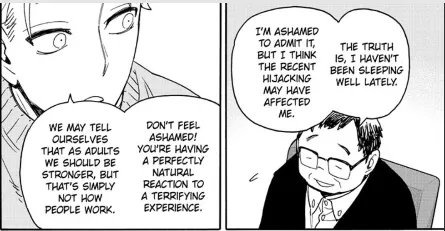
Mr Austin has done the brave thing and turned up looking for help, and Twilight/Dr Forger responds by putting his problems into context, and normalising the experience for him. We love to see it. This is SO important to trauma-informed working.
2. Providing reassurance and expectations for recovery ✅

I love this even more because what Twilight is saying is true. Only 10% of people who experience a potentially traumatic event actually develop PTSD symptoms, and of those, 70% will recover within the year. Twilight is reiterating the message that acute trauma is absolutely recoverable.
3. Teaching and demonstrating coping skills ✅

It's not enough for clinicians to simply tell their patients about coping skills, it is essential to demonstrate them too. Bringing the practice of coping skills into the therapy room is so important for helping the patient to build their skills, and to build the therapeutic alliance as well.
Here, Twilight is teaching a simple breathing technique, but I would also commend him for teaching other coping skills: grounding, distraction, progressive muscle relaxation, visualisation, and more - although all/most of these rely on breath control as a foundation.
4. Encouraging guided self-help and making medical reccommendations ✅✅
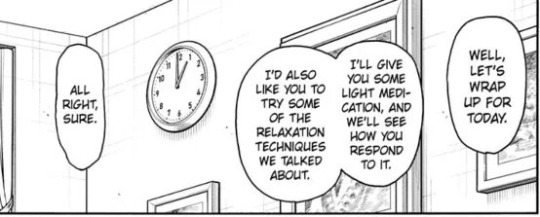
Just trying a breathing exercise once does not make recovery easy. Twilight knows it's important to encourage patients to do this in their own time.
And, finally, we see him acting as a psychiatrist, and reccommending medication. (Although, let's temporarily ignore that as a spy he has NO TRAINING in psychopharmaceuticals).
5. Breaching confidentiality ❌ Confrontational approach ❌

Oh, Twilight... You have fucked up. Big time. This is the biggest fuck up of the entire session.
It's his SECOND session with this patient, and not only does he take a confrontational approach (putting Mr Austin on the defensive, definitely not conducive to a good therapeutic relationship), but he has BREACHED CONFIDENTIALITY. Depending on severity this is A FIREABLE OFFENCE (even in the UK!).
6. Positioning oneself as the 'expert' ❌ Telling the patient to confront their abuser❌ Not taking into account patient's readiness for change ❌

Oh HELL no. Absolutely not. Confronting fear is a delicate and lengthy process requiring many steps, and always checking in with the patient at every step of the way. It cannot go too fast.
The therapeutic relationship is an alliance, and it's important to empower the patient to make their own choices in therapy, especially if it's something that is a source of fear.
Not only that, but telling anyone to confront their abuser is straight up the worst advice ever. It's not safe.
6.5 Providing rationale and reassurance✅
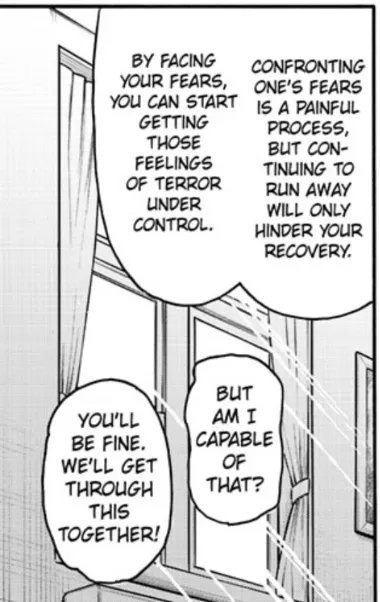
Okay, I'll concede on this point. Twilight's rationale is sound: in the 'Cycle of Anxiety', Avoidance is a key factor in maintaining one's fear of something, and it is a core criterion in PTSD. Learning how to face a fear is really important to PTSD recovery.
And it's good that Twilight attempts to reassure Mr Austin's concerns.
7. Giving unsolicited relationship advice ❌
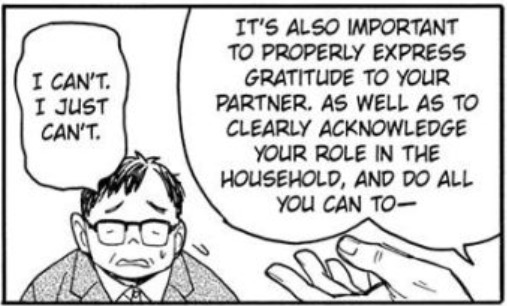
This is NOT your role, Twilight. You are outside the bounds of your job description. It's an admirable effort to connect with the patient, but, alas, not appropriate at this time.
8. Not taking risk into account ❌❌❌
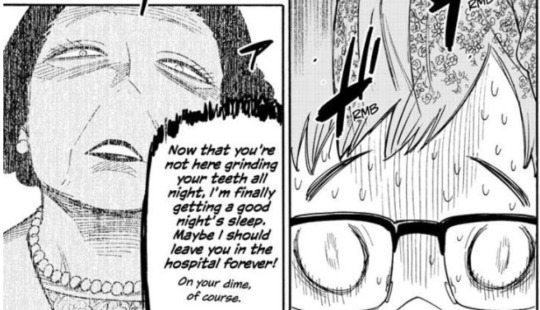
This is a BIG one. It is not normal for a person to be so afraid of their spouse to be showing all the typical symptoms of a fight-or-flight fear response (sweating, shaking, racing thoughts, muscle tension, pupil dilation, etc.), and Twilight is missing some pretty obvious cues to indicate that Mr Austin is in a clearly unsafe situation.
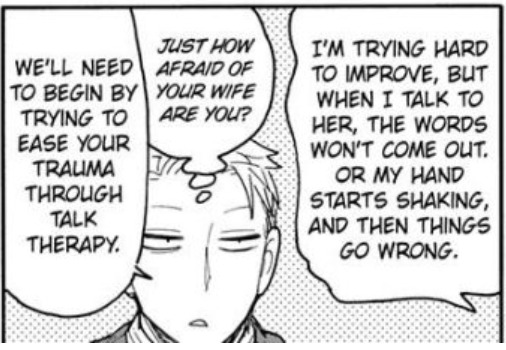
HE IS LITERALLY TELLING YOU TO YOUR FACE!!
AND if its bad enough that Mr Austin can't even speak, that means his fear is bad enough to completely shut off his pre-frontal cortex (the centre of executive function, rational thought and decision making), which means that his fear is THAT bad. Add this up with the insomnia, chronic fatigue, frequent dissociation, irritability and mood swings, and suddenly it is bad enough to be considered a trauma response - and Twilight still doesn't question the source of this trauma.
Also, Twilight, you can afford to put the judgement aside. Please.
9. Facilitating an unsafe exercise ❌ Risking psychological safety ❌
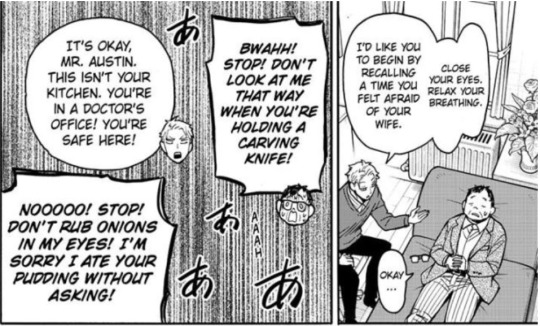
Here Twilight is attempting a basic exercise inspired by exposure therapy (which Twilight is NOT trained in because he is a spy). While it is a therapy that has a decent evidence base, you don't to therapy to a patient, you do it with them, i.e. it's a process that needs to have a clear goal with informed consent.
In this instance, Twilight didn't prepare Mr Austin for the exercise, and he ended up in an actual flashback with very high levels of emotional distress. Unsafe.
And, again, psychiatrists do not typically deliver talk therapy - that is the job of psychologists.

Conclusion
Why did I make this thread?
I'm really happy that Endo put in the effort to illustrate a really interesting therapy session, bringing psychology and trauma into the forefront. These are sensitive topics and I applaud Endo for giving a really complex topic airtime, and doing the research into what a proper therapy session looks like - because, for all my criticisms here, it is a pretty decent represention of what therapy can look like. [Especially the good bits!]
I also think this scene/chapter alone does a great job of reducing the stigma of seeking help for mental illness. It's great to see in mainstream media, especially something as popular as Spy x Family, since Japan does have a high suicide rate and intense stigma for those suffering from mental illness.
However, I still felt the criticisms of Twilight's therapy session were important to voice.
We cannot forget that he is not a trained clinician. He is there to gather information on his patients and their families and connect him to the upper classes, which explains his confrontational approach and disregard to psychological safety.
As much as Twilight has truly absorbed the psychiatry textbooks and committed their content to memory, the effects of the lack of training is obvious, showing up as major errors in his clinical practice - some of which could get him fired in today's system.
TL;DR Twilight is a GREAT spy. But a therapist? Not your calling, my friend.
#initially posted on Twitter#somehow I am compelled to bring this up#sorry I guess#spy x family#twilight sxf#thanks for listening#sorry for this massive rant#let me know your reflections idk
128 notes
·
View notes
Text
The Magick of Gratitude
It's all about learning how to navigate and shift through challenging circumstances, challenging situations through utilizing the power of gratitude. So, we'll talk about it like this: when you feel as if you are stuck in some type of rut, when your life feels stagnant, when you feel blocked; oftentimes the reason for many of these things energetically speaking because of some type of judgement that is being held about either the situation or about oneself. And judgement inherently is not a negative thing however judgment will create the idea of limitation. For example you can judge something positively and you can judge something negatively.
But once you have judged something you have sort of pigeonholed it you have defined it. And that definition creates a certain gradation and while judgement does have its uses in being able to really navigate the physical reality in a more primitive sense being able to differentiate between a type of a tiger, a predator, and a friend and family member in your modern society what you would consider to be judgement can at times become an obstacle, can at times become a self-imposed blockage that prevents you from really seeing the bigger picture.
Because once you have judged something negatively, you have in a sense eliminated your ability to see how that thing could manifest in a positive way. You have limited your perception so it's ability to serve you in a positive way is then less perceivable to you. When you judge something in a positive way, the same thing takes effect where you have limited your ability to see how that thing could serve you in potentially a negative way. Because both positivity and negativity are a form of service because both positive and negative experiences can nourish the soul can grow the soul and can give you experience. Which is a type of spiritual nourishment.
When someone is judging something positively oftentimes you will see that thing with what you call rose colored glasses, and while there is use in that ultimately there may be dimensions to that thing which are not inherently positive. And the individual will miss those perceptions and eventually what they'll find is the thing that they were judging as absolutely positive is in fact not really so. And the same can be found for negative judgment. Where when a person has judged something negatively, they only see it as a negative manifestation.
And even though that thing may have the potential of serving them positively, they are unable to perceive that. However, as all of you have experienced in different ways, even the things that you have labeled as negative may appear to be negative at first at a certain point when you overcome that challenge, you end up finding that it did in fact serve you in some way shape or form; that there was some type of positive dimension to it that you were able to extract through overcoming that particular challenge.
The reason we are emphasizing this so clearly, So you could say distinctly, is because while judgment may serve you the way to perceive that will serve you the most is, neutrally because all things within your dualistic expression of reality will contain both positive and negative frequencies. All things will contain what you call Yin and yang. As you know, even the most positive of states can eventually reveal to you negative things. And in that sense the polarity shifts, the polarity flips. Even the most negative of things can reveal to you the most positive of things, and in the instance the polarity flips.
When you are able to observe things neutrally, You hold space for both positive and negative thus allowing for you to see the totality of that which is perceivable to you in the moment of that particular subject matter. So when you see things free of judgment, ultimately you are more empowered; you are more informed. And ultimately you are more allowing of your higher guidance to reflect back to you whatever you need to see in that moment. And to share with you the instructions, the intuition and the forms of guidance that allow for you to form an appropriate and beneficial relationship to that particular subject.
So when you see things free of judgment, you are seeing things as Source sees things. Because Source recognizes the dualistic dimensions of all of its creations because Source is the only level of existence where there is no duality, there is only the One. Anything other than that, even the dimensions of Source that are aware of itself will express the idea of some type of duality. For example, the dimension of Source, the example of the One, that is aware of itself is what you call the two. And this dimension of Source which is aware of itself can be divided into two portions. There is the idea of the yin portion to it, and the yang portion to it. And these two yin and yang dimensions interact with one another and that is what gives rise to the myriad of realities and manifestations that Source creates.
So the one is the only level where there is no experience and because of that there is no duality. And when you see things neutrally, when you see things free of judgment, you are aligning with that particular level of Source. And when you are aligning with that particular level of Source, you are able to look down onto the myriad of creations that you are giving rise to and that allows for you to see both positive and the negative yin and yang dimensions clearly just as Source is able to do when it looks into itself and is able to see the myriad of realities that it's engendering. So, one of the ways that you can really expand your perspective through expanding your perspective and overcome challenges, or what you would call blockages or obstacles is through embodying the power of gratitude.
As we have said both positive and negative things are capable of serving you because they grant you experiences and that is what causes you to evolve and that is what causes you to grow and expand in yourself. Therefore, there is an inherent generosity present in both positive negative experiences both are giving you a gift, both are giving you something of value. So when you tune into the frequency of gratitude you are actually tuning into your natural state. You are tuning into the foundational dimension that is present inherently in all experiences. Because when you choose to experience life from a state of gratitude you are acknowledging that both positive and negative things can serve you.
And that allows for you to extract the highest levels of benefit, the highest level of value from those things. When those things are, let's just say judged either positively or negatively in that sense of gratitude may not be there fully. And what we mean by this is if you only accept the positive and you are only grateful for this and you judge the negative and reject it; you are not in a complete state of gratitude. You are in a state that we would translate as conditional gratitude. Which means you are really only half alive. You are really only turning on half of your consciousness.
You are really only activating half of yourself. However, when you choose to remain grateful whether you are experiencing a positive thing or a negative thing you have activated all of yourself. Because that neutral center point is what allows for you to have a 360 degree point of view that includes all experiences, it doesn't shun them and it doesn't push them away. It doesn't value one and devalue the other. It allows them to be and that allows for you to receive the higher wisdom and the positive energy that you can then use to navigate those experiences of positivity and negativity in a way that will ultimately serve you the most.
When you face a negative challenge and you go into a state of gratitude you are actually shifting the energy of that negative theme that's being explored and in that moment it is no longer a purely negative theme and you have chosen to be grateful for that theme you are activating your awareness of positivity in the face of the negative theme which allows for you to see how that theme may actually serve you, how it may benefit you and how you can use it in an uplifting way. So what we would advise is if you are dealing with some type of psychic block or emotional block, or mental block experiment for a little bit with practicing gratitude for those things that you are feeling, for those things that you are experiencing.
And when we say, become grateful for these things, we are not attempting to invalidate the challenge, or the pain, or the suffering, that may be connected to those things. We understand that those things are there. We understand that suffering does not feel good for many of you. We understand pain does not feel good for many of you. However, when you begin to become grateful for those things which perhaps are engendering suffering and/or pain, what ends up happening is you are disentangling yourself from the identity of the one who suffers. You are disentangling yourself from the identity of the one who is in pain and through that disentanglement, space is then made available within your consciousness. And because you're using gratitude you are flavoring that new created space with positivity which then allows for you to draw in positive realizations, positive experiences, and positive decisions.
-Ryokah 👽 (Channeled by Tyler Ellison)
17 notes
·
View notes
Text
How Do You Fix A Lack Of Confidence?
For women with a strong desire for self-empowerment and the pursuit of a more fulfilling life, addressing and rebuilding self-confidence is a foundational step in their transformative journey. This post provides an in-depth exploration of tailored strategies, focusing on practical steps to overcome a lack of self-confidence and pave the way for a life characterized by empowerment and personal growth.
Identifying Personal Triggers and Limiting Beliefs:
The first step in fixing a lack of self-confidence is identifying the specific triggers and limiting beliefs that contribute to feelings of inadequacy. This section emphasizes the importance of self-reflection and introspection to pinpoint the root causes of low confidence, enabling women to address them directly.
Cognitive Restructuring for Positive Self-Talk:
Transforming negative thought patterns is a key component of rebuilding self-confidence. This section delves into cognitive restructuring techniques, teaching women how to replace self-doubt with positive self-talk. Practical exercises and examples guide individuals in cultivating a more optimistic and empowering internal dialogue.
Goal-Setting for Incremental Success:
Setting realistic and achievable goals is instrumental in rebuilding self-confidence. This section explores the process of goal-setting, emphasizing the importance of breaking down larger aspirations into smaller, manageable steps. Celebrating incremental successes creates a positive feedback loop, reinforcing a sense of accomplishment and confidence.
Embracing Personal Achievements:
Acknowledging and celebrating personal achievements is a crucial aspect of building self-confidence. This section encourages women to create a personalized achievement journal, where they document and reflect on their successes. By recognizing their capabilities and accomplishments, individuals gradually rebuild a positive self-image.
Developing and Showcasing Skills:
Actively developing and showcasing skills contributes significantly to self-confidence. This section provides guidance on identifying strengths and cultivating new abilities. Whether through formal education, online courses, or skill-based workshops, women can enhance their competencies and build confidence in their capabilities.
Building a Supportive Social Network:
Surrounding oneself with a supportive social network is essential in overcoming a lack of self-confidence. This section explores strategies for building and nurturing connections with individuals who uplift and encourage personal growth. A strong support system provides validation and reinforcement during the confidence-building process.
Positive Affirmations and Visualization Techniques:
Implementing positive affirmations and visualization techniques is a powerful tool for rebuilding self-confidence. This section provides practical exercises for creating personalized affirmations and incorporating visualization into daily routines. Visualization helps individuals envision success and reinforces a positive self-perception.
Mindfulness and Stress Reduction:
Incorporating mindfulness practices and stress reduction techniques is vital for enhancing self-confidence. This section explores the benefits of mindfulness meditation, deep breathing exercises, and other relaxation techniques. By managing stress, individuals create a mental space conducive to building and sustaining confidence.
Accepting Constructive Criticism and Learning from Mistakes:
Embracing constructive criticism and viewing mistakes as opportunities for growth is integral to the confidence-building process. This section guides women in adopting a growth mindset, emphasizing the importance of learning from setbacks rather than viewing them as indicators of incompetence.
Personal Style and Self-Care:
Expressing personal style and prioritizing self-care contribute to a positive self-image and, consequently, improved confidence. This section explores the transformative impact of adopting a style that aligns with one's identity and emphasizes the importance of self-care practices in fostering self-confidence.
If you want to learn how you can build your self-confidence check out my new comprehensive 94 page ebook that is a virtual guide to help YOU build your self-confidence that includes 13+ customisable features including printable templates, plans and quizes that were made to help YOU on your journey.
CHECK IT OUT HERE
#confidence#low self-confidence#how do i fix my lack of self-confidence#how do i fix my low self-confidence#how do i build my self-confidence#self-confidence#how do i build my self-esteem#how do i build my self-respect#self-esteem
9 notes
·
View notes
Text
Book Review: Good Vibes, Good Life by Vex King
Welcome to another edition of Read with Rupa! Today, I’m excited to dive into Good Vibes, Good Life by Vex King, a book that has been making waves in the world of self-help and personal development. As a professional writer and passionate book reviewer, I’m always on the lookout for works that not only inspire but also offer practical insights. Vex King’s Good Vibes, Good Life promises both, and I’m here to share my thoughts on this transformative read.
Synopsis
In Good Vibes, Good Life, Vex King offers readers a blueprint for personal growth and happiness through the power of positivity. Drawing on his own experiences and spiritual teachings, King presents a series of practical lessons designed to help individuals cultivate a mindset that attracts positivity and improves overall well-being. The book is divided into key themes including self-love, mindfulness, and the importance of maintaining a positive attitude in the face of life’s challenges.
Writing Style and Structure
King’s writing is refreshingly accessible and engaging. His conversational tone makes complex concepts feel relatable and easy to understand. Each chapter is structured to address specific aspects of personal development, with actionable advice and reflective exercises. King’s use of personal anecdotes and real-life examples adds depth and authenticity to his messages, making them resonate on a personal level.
Key Themes
Self-Love and Acceptance: One of the core messages of Good Vibes, Good Life is the importance of self-love. King emphasizes that true happiness starts from within and that accepting oneself is crucial for personal growth. His practical tips for cultivating self-love are both empowering and practical, encouraging readers to embrace their unique qualities and value themselves.
Mindfulness and Positivity: King explores the concept of mindfulness and its role in maintaining a positive outlook on life. He provides actionable strategies for incorporating mindfulness practices into daily routines, such as meditation and gratitude exercises. These practices are designed to help readers stay grounded and focused, fostering a more positive and fulfilling life experience.
Overcoming Challenges: The book acknowledges that life’s challenges are inevitable, but King argues that our response to these challenges can determine our overall happiness. He offers guidance on shifting negative thought patterns and developing resilience, encouraging readers to view obstacles as opportunities for growth.
Manifestation and Energy: Another intriguing aspect of Good Vibes, Good Life is King’s exploration of manifestation and energy. He discusses how our thoughts and feelings influence our experiences and offers practical advice on harnessing positive energy to attract desired outcomes. King’s approach to manifestation is grounded in practical steps, making it accessible to readers of all backgrounds.
Strengths
Good Vibes, Good Life excels in its practical approach to personal development. King’s ability to distill complex ideas into actionable advice is one of the book’s greatest strengths. The reflective exercises at the end of each chapter provide readers with tools to implement the concepts discussed, enhancing the book’s value as a guide for personal growth.
King’s candid sharing of his own experiences adds a layer of relatability and authenticity to the book. His positive and encouraging tone creates an uplifting reading experience, making it easy for readers to connect with and be inspired by his messages.
Critique
While Good Vibes, Good Life offers valuable insights, some readers may find that the book covers familiar ground if they have already explored similar self-help literature. Additionally, the emphasis on positive thinking and manifestation might not resonate with everyone, particularly those seeking more scientific or evidence-based approaches to personal development.
Conclusion
Overall, Good Vibes, Good Life by Vex King is a compelling and inspiring read for anyone interested in personal growth and self-improvement. King’s engaging writing style, practical advice, and emphasis on positivity make it a worthwhile addition to the self-help genre. Whether you’re new to the world of personal development or looking to deepen your understanding, this book offers valuable insights and actionable steps to help you lead a more fulfilling life.
If you’re ready to embrace the power of positivity and take control of your own happiness, Good Vibes, Good Life might just be the book you need. Join me in exploring its transformative messages and discover how you can create a life filled with good vibes and lasting joy.
Happy reading!
— Rupa

2 notes
·
View notes
Text
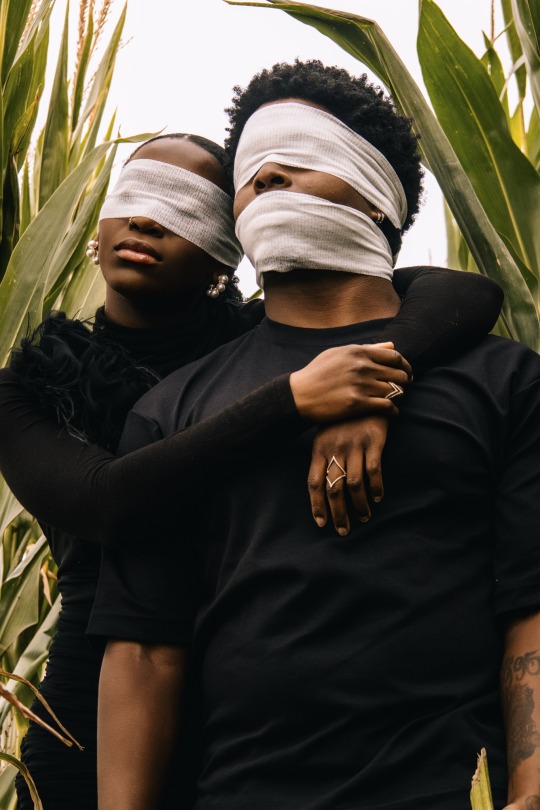









“Blinded by Love” – Exploring the Obsession and Vulnerability of Love
Blog Written by: Eric Harris
At Your Beauty Studios, our projects are born out of a desire to capture raw emotions and tell stories that resonate deeply with the human experience. Our latest photography project, Blinded by Love, delves into the complex and often overwhelming nature of love, exploring how it can cloud judgment, consume individuals, and make them vulnerable. Through carefully crafted imagery, we invite viewers to reflect on the duality of love—its beauty and its dangers.
The Concept: When Love Becomes Blind
The phrase “blinded by love” is familiar, often used to describe situations where love distorts reality, making people overlook flaws or even harmful behavior. In this photoshoot, we aim to visually represent that metaphorical blindness, portraying love as both a source of joy and a potential trap. The images feature individuals who are metaphorically “blinded”—through symbolic props like blindfolds, shadowed lighting, or abstract elements—demonstrating how love can obscure one’s perception.
Themes of Vulnerability and Surrender
Love requires vulnerability—opening oneself to another person and, in many cases, surrendering control. This project captures moments of that surrender, showing how love can leave us exposed, for better or worse. Some photos highlight the beauty of this vulnerability: moments of trust, affection, and connection. Other images take a darker turn, revealing how being “blinded” by love can lead to manipulation, loss of self, or entrapment in toxic dynamics.
Visual Symbolism: The Blindfold
A recurring symbol throughout the shoot is the blindfold, representing how love can act as both a veil and a shield. The blindfold hides reality, preventing the wearer from seeing their surroundings clearly. It can symbolize passion, where people are so caught up in emotion they lose their sense of self or logic. However, in some photos, the blindfold is depicted as a protective barrier, suggesting that sometimes love protects us from harsh truths or painful realities.
The Tension Between Freedom and Constraint
One of the core tensions explored in this project is the balance between freedom and constraint in relationships. Love can liberate, offering emotional intimacy and personal growth. But it can also bind, creating dependencies or power imbalances. In the images, subjects appear in various states—some liberated, arms outstretched as if soaring with love’s freedom, while others are tied, bound by emotional or symbolic constraints. This contrast highlights the push and pull that love often brings into our lives.
A Reflection of Personal Experience
Each image in Blinded by Love reflects different aspects of relationships—some tender, others haunting. Our goal was to capture the universal yet deeply personal nature of love’s impact on individuals. Whether it’s the heady excitement of falling in love or the painful disillusionment when love fades, this project speaks to the highs and lows we all experience in our emotional lives. The use of stark contrasts in lighting and composition reinforces these emotional extremes.
The Emotional Palette: Love’s Many Shades
The photoshoot is rich with a dynamic color palette, from soft pastels that reflect tenderness and affection to deep, dramatic shades of red and black that symbolize passion, obsession, and danger. These visual cues are meant to evoke an emotional response, encouraging viewers to see love not as a single emotion but as a spectrum that can encompass everything from joy to despair.
Conclusion
Blinded by Love is more than just a visual representation of relationships—it’s a reflection on the ways love can empower us, but also how it can blind us to our own needs or reality. At Your Beauty Studios, we are passionate about creating artwork that challenges perceptions and encourages deeper reflection on emotions that define our lives. We hope this photoshoot sparks conversation about the duality of love—the beauty and the risk that come with surrendering ourselves to it.
http://instagram.com/yourbeautystudios
By: Eric Harris
#blinded by love#blindedbylove#couple art#black beauty#deep connection#short story#story by Art#story through art#love and trust#love and romance#strong bound#love story#SoundCloud#so hot 🔥🔥🔥#halloween
3 notes
·
View notes
Text
Mindfulness & Personal Evolution: The Journey to Authenticity

Ever feel like you're playing a part in life's grand theater, but the script doesn't quite resonate? It's a common yearning, this desire to shed layers, step out of the shadows, and truly shine as our authentic selves. And guess what? There's a path paved with mindfulness and potent tools that can guide you on this exciting journey of personal evolution.
Hold on, though, before diving headfirst into life-altering transformations. This isn't about becoming someone "new" (unless that someone is simply a more genuine version of you!). It's about shedding limiting beliefs, assuming your true essence, and radiating authenticity from within. And that, my friend, is where mindfulness comes in.
Mindfulness: Your Introspective GPS
Think of mindfulness as your personal GPS for navigating the vast landscape of the self. You become attuned to your thoughts, emotions, and impulses without judgment by cultivating present-moment awareness. This allows you to:
Recognize conditioned patterns It's important to be aware of the conditioned patterns that may be hindering your personal growth and success. These patterns could be in the form of automatic behaviors, self-imposed limitations, and emotional triggers that are deeply ingrained in your psyche. Identifying and recognizing these patterns is the first step towards breaking free from their grip and achieving your full potential.
Make conscious choices By making conscious choices, you are able to avoid being overwhelmed by reactive impulses and instead, make decisions that are in line with your authentic self. This involves being intentional and thoughtful about your actions, and taking steps to ensure that your choices reflect your values and priorities. By doing so, you can lead a more fulfilling and purposeful life.
Welcome self-compassion To nurture an untroubled and accepting state of mind, it's crucial to abandon the habit of criticizing oneself and adopt self-compassion instead. Treating oneself with kindness and understanding assists in fostering a gentle and forgiving attitude towards oneself, which can have a significant impact on one's overall well-being.
Unveiling Your Authentic Tapestry
Just picture this for a moment - what if you could combine the incredible power of mindfulness with a range of amazing tools like Life Coaching, Money Coaching & Abundance Coaching, Relationship Coaching, Law of Attraction Coaching, Mindset Coaching, Aura Scans & Aura Cleansing, and Color Therapy?
At Gateway of Healing, we offer an incredible array of services that will help you on your transformational journey, each thread adding a unique and vibrant layer to the tapestry of your life. Let us empower you to become the best version of yourself!
Life Coaching Your personal guide, helping you unearth your values, goals, and deepest desires. It's like having a cheerleader and strategic advisor in one, holding you accountable and celebrating your victories.
Money Coaching Unraveling limiting beliefs around money and abundance, and creating a mindset of financial freedom. Imagine attracting prosperity while aligning it with your authentic values.
Relationship Coaching Steering through the complexities of love, communication, and healthy boundaries. This isn't just about romantic relationships; it's about cultivating healthy dynamics in all aspects of your life.
Law of Attraction Coaching Harnessing the power of your thoughts and intentions to attract your desires. Understand the principles of manifestation and learn to cultivate positive energy for abundance in all areas.
Mindset Coaching Reprogramming limiting beliefs for a growth mindset. This is where you challenge self-doubt, welcome challenges, and step into your full potential.
Aura Scans & Cleansing Gaining insights into your energy field and releasing blocked emotions. Think of it as a spiritual spring cleaning, clearing the way for your authentic light to shine through.
Color Therapy Harnessing the power of color to influence your mood, emotions, and well-being. Surround yourself with energizing colors or use specific hues to promote relaxation and balance.
Remember, personal evolution is a journey, not a destination. It's a continuous process of exploration, self-discovery, and adopting your authenticity. At Gateway of Healing, we walk alongside you, offering guidance, tools, and a supportive community to empower your transformation.
Ready To Venture On Your Adventure? 4 Tips To Get You Started
Start small Pick one area you'd like to explore, like mindfulness practice or a specific coaching program. Consistency is key, so begin with manageable steps.
Adopt self-compassion Be kind to yourself on this journey. There will be ups and downs, and that's okay. Celebrate your progress, big and small.
Find your support system Surround yourself with positive, encouraging people who believe in your journey. Connect with our community or find like-minded individuals who share your path.
Trust the process Allow yourself to evolve and change at your own pace. This is a journey of self-discovery, not a race.
At Gateway of Healing, we believe that everyone has the potential to live a life of authenticity and fulfillment. With mindfulness as your compass and powerful tools at your disposal, you can steer through the journey of personal evolution and shine your brightest light. Remember, you are already enough, but there's an even more magnificent version of you waiting to be discovered.
Let's venture on this adventure together! P.S. Don't forget to explore the wealth of resources and articles on our website. We have something for everyone seeking guidance on their path to self-discovery and authenticity.
#Mindfulness#Personal Evolution#Self-Discovery#Mindfulness Practices#Self-Compassion#Life Coaching#Money Coaching#Abundance Coaching#Relationship Coaching#Law of Attraction Coaching#Mindset Coaching#Aura Scans#Aura Cleansing#Color Therapy#Growth Mindset#Supportive Community#dr.chandnitugnait#gatewayofhealing#businesscoach#life transformation#manifestationcoach#lifecoach
7 notes
·
View notes
Text
Palmistry Myths vs. Reality: Understanding the Truth Behind Palm Reading
Palmistry, the fascinating art of palm reading, has intrigued people for centuries. Many seek its guidance, hoping to uncover hidden truths about themselves, their future, and their relationships. However, along with its rich history and potential insights, palmistry is also surrounded by numerous myths and misconceptions. In this blog, we’ll dive deep into some of the most common myths versus the realities of palm reading, revealing how this ancient practice can bring clarity and understanding to your life.
What Is Palmistry?
Before we unravel the myths, let's take a moment to understand what palmistry really is. At its core, palmistry is the study of the lines, shapes, and mounts of the hands. Each person’s palm is unique, reflecting their personality, potential, and life experiences. Through careful observation, a skilled palm reader can gain insights into a person's character, challenges, and opportunities.

The Roots of Palmistry
Palmistry has its origins in ancient civilizations, including India, China, and Greece. It’s intertwined with various cultural practices, including Vedic astrology. In Vedic traditions, palm reading is often seen as a companion to astrology, providing additional layers of understanding about one’s life path. This rich history adds depth to the practice, showing that palmistry is not just a fleeting trend but a time-honored approach to self-discovery.
Myth 1: Palm Reading Is Just Fortune-Telling
One of the biggest misconceptions about palmistry is that it’s solely about predicting the future. While it’s true that some palm readers may focus on forecasting events, the reality is much broader and richer. Palmistry is more about self-discovery and personal insight than about seeing into a crystal ball.
Reality: It’s About Self-Discovery
When you engage in palm reading, you’re not just looking for predictions; you’re exploring the depths of your personality and life experiences. Your palms can reveal patterns in your behavior, your strengths, and your potential areas for growth. By understanding these aspects, you can make more informed choices, ultimately leading to a more fulfilling life.
How Palm Reading Can Empower You
Many people seek palm reading during times of transition—perhaps after a major life change or when feeling lost. The insights gained from palmistry can offer a fresh perspective, helping you understand why you react to certain situations in specific ways. This self-awareness can lead to empowerment, allowing you to navigate life’s challenges with greater confidence.
Myth 2: Palm Reading Is Superstitious Nonsense
Some skeptics dismiss palmistry as mere superstition, believing it to be devoid of any real value or scientific basis. They view it as a form of entertainment rather than a genuine tool for understanding oneself.
Reality: A Skill Developed Over Centuries
While palmistry may not be scientifically proven in the same way as some fields, it is built on centuries of observation and practice. Experienced palmists study the intricacies of hand shapes, finger lengths, and the various lines that form on the palm. This knowledge provides valuable insights that can be both practical and meaningful.
The Intersection of Palmistry and Vedic Astrology
As mentioned earlier, palmistry is closely linked to Vedic astrology. In this tradition, your palm can provide insights that complement your astrological chart. For instance, a strong Mount of Jupiter on your palm may reflect the leadership qualities indicated by Jupiter in your birth chart. By combining these two practices, you gain a more holistic understanding of your personality and life path.
Myth 3: Only Certain People Can Read Palms
Many believe that palm reading is an exclusive skill reserved for a select few, often mystics or fortune-tellers. This perception can discourage individuals from exploring palmistry for themselves.
Reality: Anyone Can Learn Palmistry
The beautiful truth about palmistry is that anyone can learn to read palms with practice and patience. There are numerous resources available, from books to online courses, that can guide you through the basics. With an open mind and a willingness to learn, you can start interpreting the signs in your own palm or those of your loved ones.
Finding Your Style
As you delve into palm reading, you’ll likely find your unique approach to interpreting palms. Some people focus on the lines, while others pay attention to the mounts and shapes of the hands. Embrace your style and let your intuition guide you. This personal touch will make the experience even more rewarding.
Myth 4: Palm Reading Is Only for Women
Another common myth is that palmistry is primarily a women’s domain. While many women are drawn to the art of palm reading, this practice is for everyone, regardless of gender.
Reality: A Universal Tool for Insight
Palmistry is a universal practice that transcends gender. People of all backgrounds can benefit from understanding the insights offered by their palms. In fact, many men find palmistry to be a valuable tool for self-reflection and personal growth.
The Benefits for Everyone
Whether you’re seeking clarity in your career, relationships, or personal goals, palm reading can offer valuable insights. The practice encourages self-exploration and introspection, making it a beneficial tool for anyone looking to deepen their understanding of themselves.
Myth 5: Palm Reading Is Only for the Curious
Some view palmistry as a trivial pursuit, something to do for fun but not to be taken seriously. This misconception overlooks the profound value that palm reading can bring to your life.
Reality: A Serious Path to Personal Growth
Palm reading can be a powerful means of personal growth and transformation. When approached with sincerity, it encourages self-examination and can illuminate patterns that you may not have been aware of. By understanding your strengths and weaknesses, you can set more meaningful goals and make positive changes in your life.
Using Palmistry as a Tool for Reflection
Consider taking time to reflect on what your palm reveals about you. What do the lines say about your emotional experiences? How do the mounts indicate your natural inclinations? This reflective process can lead to profound insights and a greater sense of purpose.
The Emotional Connection: Why You Should Explore Palmistry
Now that we’ve debunked some common myths, you might wonder why you should consider exploring palmistry yourself. The answer lies in the emotional connection it can foster.
Discovering Your Inner Self
Palmistry encourages you to look within, offering a unique opportunity for self-discovery. By engaging with the insights your palm provides, you can confront aspects of yourself that may need attention or nurturing. This journey inward can be both healing and enlightening.
Building a Positive Mindset
Understanding the strengths represented in your palm can help you cultivate a more positive mindset. For example, if you find that your Mount of Venus is well-developed, you can embrace your natural ability to connect with others and express love. Recognizing these positive traits can boost your self-esteem and encourage you to pursue relationships and opportunities that resonate with your authentic self.
Finding Guidance in Times of Uncertainty
Life is full of uncertainties, and palmistry can serve as a comforting guide. When you’re faced with difficult decisions or feeling lost, looking at your palm can provide clarity. It’s like having a conversation with yourself, helping you navigate your path with confidence.
Embrace the Wisdom in Your Hands
In conclusion, palmistry is a fascinating practice that offers much more than meets the eye. By debunking common myths and embracing the reality of palm reading, you can unlock valuable insights into your personality, strengths, and life path.
Whether you’re seeking clarity, understanding, or personal growth, palmistry can be a powerful tool in your journey. Remember, your hands hold the stories of your life; all you need to do is take the time to listen. Embrace the wisdom in your palms and allow it to guide you toward a brighter, more fulfilling future. After all, palm reading is not just about predicting what will happen next; it’s about discovering who you are and empowering yourself to create the life you desire. So why not explore this ancient art? Your palms are waiting to share their secrets with you.
3 notes
·
View notes
Text
Life and Pictures: Entry #2
Life behind the Lens: Capturing Memories, Expressing Self, and Finding Joy

Today, photography is more than just capturing moments—it's a powerful tool for preserving memories, expressing oneself, and finding joy in leisure.
Photography is the art of capturing moments and scenes, telling stories through the lens of a camera. It's a universal experience, accessible to beginners and seasoned photographers alike. Beyond its technical definition, photography is a gateway to creativity and self-expression. It's a way to freeze time, encapsulate memories, and evoke emotions through visual storytelling.
So why should you start exploring photography? Because it offers a unique perspective on the world around you. Through photography, you can discover beauty in the mundane, find meaning in fleeting moments, and share your unique vision with others.
Let me elaborate on why you should explore photography:
Capturing Memories and Experiences: Photography is the ultimate time machine, preserving fleeting moments for eternity. Each click of the shutter immortalizes a slice of life, allowing us to revisit cherished memories and relive significant experiences. Whether it's the laughter shared among friends, the serenity of a sunset, or the quiet beauty of a morning dew, photographs encapsulate the essence of moments that would otherwise slip away into the abyss of forgotten memories.




Self-Expression: In a world brimming with voices, photography offers a unique channel for individual expression. Through the lens, we paint with light and shadow, composing visual symphonies that resonate with our innermost thoughts and emotions. Every frame is a canvas upon which we imprint our perspectives, passions, and narratives, weaving together fragments of our soul into a tapestry of visual poetry. Whether capturing the profound or the mundane, photography empowers us to articulate our inner worlds and share them with the universe.




Expressing Life in Different Ways: Life is a kaleidoscope of moments, each offering its own hue and texture. Photography allows us to peer through this kaleidoscope, capturing the essence of existence in all its myriad forms. From the rugged majesty of mountain peaks to the delicate intricacy of a dewdrop, every photograph serves as a window into the rich tapestry of life. Through our lenses, we explore the boundless diversity of human experience, revealing the beauty that lurks in the mundane and the magic that resides in the everyday.




Leisure Activity and Hobby: In a world consumed by hustle and bustle, photography beckons us to pause, breathe, and savor the beauty that surrounds us. It is not merely a pastime but a passport to adventure, inviting us to wander off the beaten path in search of hidden gems and untold stories. Whether chasing the golden light of dawn or the ethereal glow of twilight, photography transforms ordinary moments into extraordinary adventures. It is a journey of self-discovery, a quest for beauty, and a celebration of the extraordinary in the ordinary.




Engaging in photography can positively impact your life in various ways. It encourages mindfulness and awareness of your surroundings, fostering a deeper connection with the world. It can also serve as a form of therapy, allowing you to express emotions and reflect on personal experiences. Additionally, photography can be a source of inspiration, pushing you to explore new places, meet new people, and continuously evolve as an artist.
In essence, photography is more than just a hobby or profession—it's a journey of self-discovery, creativity, and connection. So, grab your camera and start capturing the world through your lens.
#photography#original photographers#blackandwhitephotography#photographers on tumblr#film photography#photo#photoblog#photographer#life#lifestyle#perspective#leisure#hobbies#hobby#picture#nature#life experiences#my experiences#self expression#expressionism#abstract expressionist art#freedom of expression#35mm#35mm film#35mm photography
3 notes
·
View notes
Text
Reflecting on cultural humility
Cultural humility is defined as the “ability to maintain an interpersonal stance that is other-oriented (or open to the other) about aspects of cultural identity that are most important to the person.” (Waters & Asbill, 2013). It’s a continuous journey of examining oneself and being open to learning from others. It entails approaching interactions with others with respect for their beliefs, traditions, and values (What is cultural humility? The Basics: Equity and Inclusion, n.d.). The five aspects of cultural humility are openness, self-awareness, egolessness, supportive interactions, self-reflection, and critique. This blog will outline the significance of cultural humility and reflect on the intervention planned by a student therapist for clients concerning cultural humility.

“The portions we see of human beings is very small, their forms and faces, voices and words (but) beyond these, like an immense dark continent, lies all that has made them.” Freya Star
Cultural humility plays a crucial role in occupational therapy by ensuring that interventions are effective and respectful of each patient's unique context, preferences, and cultural background. Before beginning the interview, obtaining informed consent from the client signifies a commitment to respecting their autonomy and rights. Cultural humility also empowers therapists to identify and address power imbalances (Anderson, 2022). For example, patients believe that they must accept the health care recommendations without raising their opinions; this is not true. Cultural humility involves understanding the impact of culture on health beliefs, acknowledging power imbalances between therapist and client, and working together with clients to create interventions that are culturally sensitive and appropriate. In occupational therapy, cultural humility also has implications for our personal lives. Through approaching interactions with people. Therefore, this can improve our relationships by fostering better empathy, comprehension, and connection. Culture has significant implications for OT intervention because it determines perceptions of health, illness, and occupation. Reberg, (2019). To interact with a client efficiently and understand their daily activities, one must be aware of their cultural background.
I was exposed to clients from the same ethnic group, which is black, from Zulu culture, and we share the same culture. It was a positive experience as we were able to have clear communication and acknowledge our culture, as we come from different backgrounds and the roots of the culture might be different. However, even though we came from different backgrounds, when I was planning intervention sessions with the CVA patient, which included dressing and bathing activities, I first obtained a consent form from her on the previous day of our intervention to ensure that I was adhering to the fundamentals of cultural sensitivity. Planning for intervention for the following day, the client was expected to do dressings of the upper and lower limbs. this was done to teach the client new techniques of dressing, such as beginning with the affected limb when dressing herself. So, I was planning to use the pants for dressing the lower limb as she doesn’t have personal clothes at the facility, and at the facility, they don’t have skirts; they only have those dresses that are easy to wear. So I asked the patient if that was okay if she dressed herself using the pants so that I wouldn’t perform an activity that was against her culture. The patient agreed to do so. This was also applied to my second patient, as before performing the dressing of the upper limb activity, I began with consent.
Then, on the other intervention with CVA, the patient asked me to teach her bathing activity, as she said she wanted to learn to bathe herself. After every intervention, the client was asked about the activity and the plan for the next session by asking her what activity she faced difficulty with and wanted to learn to perform. So, the client says she wants to bathe herself, so we plan to perform the bathing activity with the patient. On the previous day of bathing activity, I first obtained consent from the patient in order to perform the session. This was done because some old people from Zulu culture find it disrespectful if a young person looks at them naked. The patient didn’t have any problem with that.
Fieldwork is a good learning experience, as it prepares us for the future by teaching us holistic patient care. I learned that cultural humility is very important in occupational therapy, even if you share the same culture. As I’m Zulu culture, I feel like our backgrounds with the patient and I are differences. I was working with the old female. I found it difficult to work with her as I had to make eye contact when we were communicating or performing a session with the patient. When the client was feeding herself, I needed to do observation, look at the client while naked (when bathing and dressing),provide commands to the patient in terms of what she must do, and also call her by her name. This was against my Zulu culture, as we are not allowed to look at old people when they are naked or eating and also call them by their names; they want us to call them Aunt if they are female and Uncle if they are male. It forms part of my disrespect as a young female.
This situation enriched my knowledge in terms of intervention. I went back and did research, and I remembered that as an occupational therapy student, I will be working with people and teaching them how to bathe and dress themselves. I think I need to have more knowledge on how to respect the work without violating your culture. As I continue my journey as an occupational therapist, I have learned that cultural humility is important, and I need to consider it when planning interventions so that they can be client-centered. I have to ask my colleagues in terms of how to handle the challenge that I faced in terms of cultural barriers while continuing with research. I believe that the feedback that I will receive will be helpful. I am aware of the challenges I will face along the way in occupational therapy. I am willing to learn so that my patients will always get culturally sensitive and appropriate care. Cultural humility is important as it can transform the way we interact with others in both our personal and professional lives. Cultural humility can also help us build a good rapport with our patients, which will allow us to get to know them better and provide an effective intervention for them.
In conclusion, cultural humility stands as a cornerstone in the practice of occupational therapy, facilitating not only effective interventions but also fostering genuine connections with patients. Through a journey of self-reflection, openness, and continuous learning, therapists can navigate diverse cultural landscapes with sensitivity and respect. As demonstrated in the experiences shared, cultural humility is not only about recognizing differences but also about actively seeking understanding and adapting interventions to honor individual backgrounds and preferences. By embracing cultural humility, therapists can ensure that their practice is truly client-centered, enhancing the quality of care and nurturing meaningful therapeutic relationships.
references
Waters, A., & Asbill, L. (2013, August). Reflections on cultural humility. CYF News. Retrieved from https://www.apa.org/pi/families/resources/newsletter/2013/08/cultural-humility.aspx
What is Cultural Humility? The Basics | Equity and Inclusion. (n.d.). Inclusion.uoregon.edu. https://inclusion.uoregon.edu/what-cultural-humility-basics#:~:text=%E2%80%9CCultural%20humility%20involves%20an%20ongoing
Anderson, S. H. (2022). Cultivating Cultural Humility in Occupational Therapy through Experiential Strategies and Modeling. The Open Journal of Occupational Therapy, 10(4), 1–7. https://doi.org/10.15453/2168-6408.1962
Reberg, J. (2019). The Importance of Cultural Humility in Occupational Therapy. Review of The Importance of Cultural Humility in Occupational Therapy. Https://Www.google.com/Url?Sa=I&Url=Https%3A%2F%2Fscholarworks.wmich.edu%2Fcgi%2Fviewcontent.cgi%3Farticle%3D4185%26context%3Dhonors_theses&Psig=AOvVaw0LFVT5cn4tQhH3d-PHMRlW&Ust=1714154018398000&Source=Images&Cd=Vfe&Opi=89978449&Ved=0CAUQn5wMahcKEwiwj_On992FAxUAAAAAHQAAAAAQCA.
University of Oregon (2021). What is Cultural Humility? The Basics. [online] Equity and Inclusion. Available at: https://inclusion.uoregon.edu/what-cultural-humility-basics.
2 notes
·
View notes